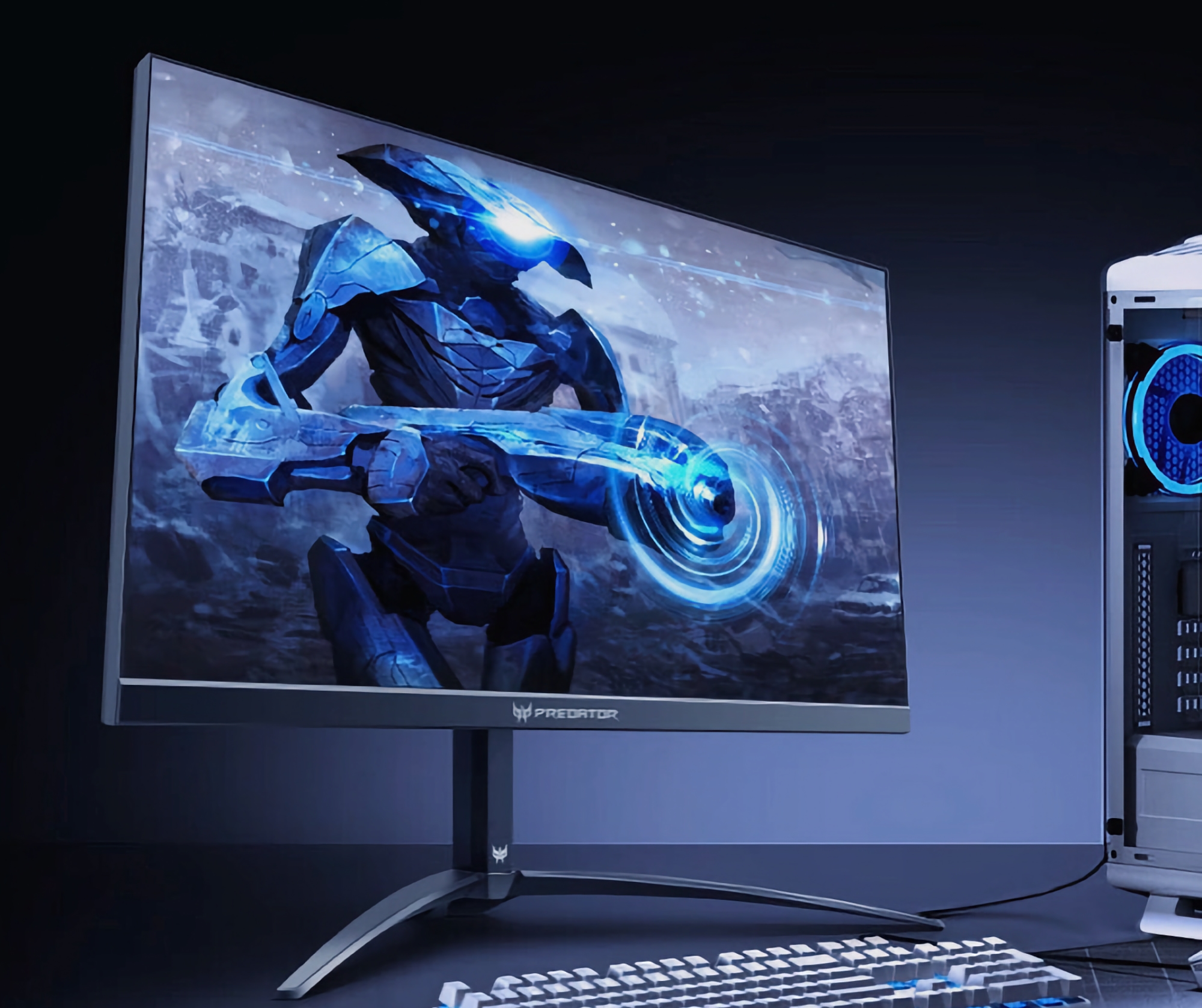The design of the monitor leans towards a subtle gaming aesthetic, making it versatile in terms of appearance. The only real gaming cues come from the stand’s design and a logo on the front. The casing and stand are primarily made from black matte plastic, while the screen’s surface has a semi-matte finish, giving it a solid, monolithic look. The display is framed by slim bezels on all sides, with a narrow strip at the bottom. Upon closer inspection, there’s a small gap between the outer edges and the actual display area – about 8mm at the top and sides, and 2mm at the bottom.
A five-way joystick is positioned on the lower right corner of the rear panel, making it accessible from below if needed. There’s a status light diffuser on the front near the right corner, and just below it, the power button.
The power and interface ports are located in a recessed area on the back, facing downward, which can make cable management tricky. Additionally, there’s a Kensington lock slot, and a plastic clip on the stand to hold the cables in place. The top of the stand features a mount, likely intended for accessories such as a webcam.
The back and perimeter of the screen block are equipped with ventilation grilles for cooling. Tiny speakers are embedded on either side of the rear panel, mounted on flexible stands, though the sound quality is basic. The stand and base are made from aluminum with a durable matte black finish, providing sturdy support while keeping the footprint on your desk minimal.
The stand allows for height adjustment with a spring-loaded mechanism, and the screen can tilt slightly forward, further back, or rotate slightly left and right. It’s easy to attach or detach the stand with a single click, and the screen can also be mounted on a VESA-compatible bracket (100x100mm).
The monitor arrives in a modestly designed, sturdy cardboard box, with foam inserts for protection. For inputs, the monitor includes four digital ports: DisplayPort, two HDMI ports, and USB-C. The input can be selected through the main menu, and there’s an option to automatically search for signals. Audio can be routed through the internal speakers or the headphone jack.
The headphone output offers sufficient power, delivering clear sound with no noticeable background noise, while the built-in speakers, though lacking in bass and sounding a bit “plasticky,” are adequate for basic use. The USB hub is available via either USB-B or USB-C, with KVM functionality allowing a keyboard and mouse to be used with two devices, such as a PC and a laptop. The USB-C port supports up to 65W of power delivery, making it convenient for charging devices.
The included cables are decent quality, though not very long. The HDMI cable supports 8K, and during testing, there were no issues with artifacting, even in extreme modes.
Display quality is customizable with plenty of brightness and color balance options. There are four built-in profiles and one user-defined profile, with three gaming settings that can be saved. Three scaling modes are available: full-screen stretch, scaling with preserved aspect ratios, and 1:1 pixel mapping. There’s also a picture-by-picture (PBP) mode, though it’s limited to 1920×1080 resolution per input.
The monitor supports 10-bit color via DisplayPort with professional-grade GPUs like Nvidia Quadro, and in testing, it performed well with HDR content. It also supports AMD FreeSync Premium Pro and is G-Sync compatible, ensuring smooth gameplay with minimal tearing.
When connected via DisplayPort or HDMI, the monitor supports up to 3840×2160 resolution at 144Hz with HDR, meeting VESA DisplayHDR 1000 certification for sustained brightness and color accuracy. Testing with the DisplayHDR test tool confirmed the monitor’s ability to handle high brightness and smooth gradients, though it falls slightly short in peak brightness.
Conclusion
The Acer Predator X32Q FS is a high-end gaming monitor with a large, vibrant 4K screen, excellent HDR support, and a robust set of gaming features. Its sleek design and versatile functionality make it well-suited for gaming, multimedia, and productivity tasks. It also functions as a dock for laptops, thanks to the 65W USB-C power delivery.
Pros:
- Sleek, subtly gaming-oriented design
- Excellent color balance and sRGB coverage
- HDR support
- Wide brightness range
- AMD FreeSync Premium Pro support
- 144Hz refresh rate
- Low input lag
- Fast response time
- Multiple gaming features, including adaptive aim
- Picture-by-picture mode
- 10-bit color support
- Adjustable stand with easy joystick controls
- Four video inputs, including USB-C with 65W power delivery
- USB hub with KVM support
- Good headphone output quality
Cons:
- No significant drawbacks

Leave a Reply